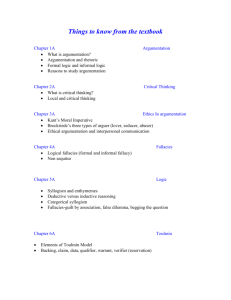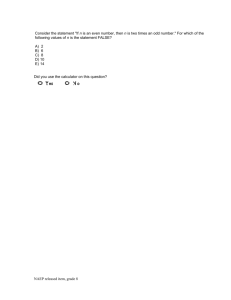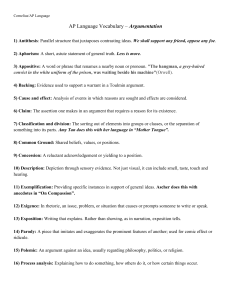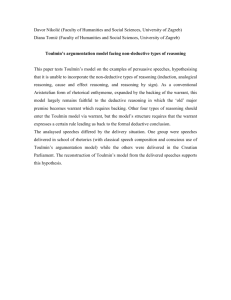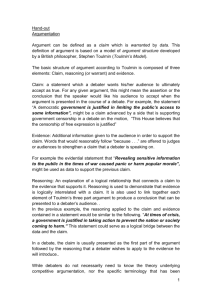Day 1 Argumentation PARTICIPANT handout
advertisement
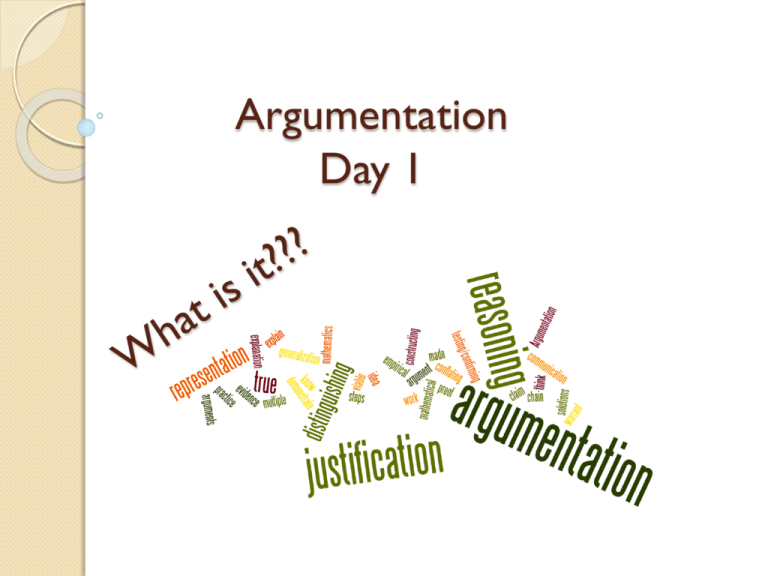
Argumentation Day 1 June 23, 2014 Standards of Mathematical Practice 1. Make sense of problems and persevere in solving them. 2. Reason abstractly and quantitatively. 3. Construct viable arguments and critique the reasoning of others. 4. Model with mathematics. 5. Use appropriate tools strategically. 6. Attend to precision. 7. Look for and make use of structure. 8. Look for and express regularity in repeated reasoning. Overarching Guiding Questions: What is a mathematical argument? What “counts” as an argument? What is the purpose(s) of a mathematical argument in mathematics? In the classroom? What does student argumentation look like at different grade levels/levels of proficiency? What are appropriate learning goals for students with respect to constructing viable arguments? What will Smarter Balanced “count” as a quality response to prompts that target Claim 3? A mathematical argument It is… ◦ A sequence of statements and reasons given with the aim of demonstrating that a claim is true or false It is not… ◦ An explanation of what you did (steps) ◦ A recounting of your problem solving process ◦ Explaining why you personally think it’s true for reasons that are not necessarily mathematical (e.g., popular consensus; external authority, etc. It’s true because my John said it, and he’s always always right.) Argumentation Mathematical argumentation involves a host of different activities: generating conjectures, testing examples, representing ideas, changing representation, trying to find a counterexample, looking for patterns, etc. When you add any two consecutive numbers, the answer is always odd. Think 1) Is this statement (claim) true? 2) What’s your argument to show that it is or is not true? Pair - Share Toulmin’s Model of Argumentation Claim Warrant Data/Evidence Toulmin’s Model of Argumentation Claim Warrant Data/Evidence THE ARGUMENT Toulmin’s Model of Argumentation Claim 7 is an odd number Data/Evidence 2 does not divide 7 evenly Warrant Definition of odd/even If it is even, 2 will divide it evenly; if it is odd, 2 will not divide it evenly Example Micah’s Response 5 and 6 are consecutive numbers, and 5 + 6 = 11 and 11 is an odd number. 12 and 13 are consecutive numbers, and 12 + 13 = 25 and 25 is an odd number. 1240 and 1241 are consecutive numbers, and 1240 +1241 = 2481 and 2481 is an odd number. That’s how I know that no matter what two consecutive numbers you add, the answer will always be an odd number Data/Evidence 3 examples that fit the criterion Warrant Because if it works for 3 of them, it will work for all Claim Note: What “counts” as a complete or convincing argument varies by grade (ageappropriateness) and by what is “taken-asshared” in the class (what is understood without stating it and what needs to be explicitly stated). Regardless of this variation, it should be mathematically sound. Commentary Argumentation is important for Teaching By eliciting reasoning, you gain insight into students’ Learning thinking – can better address misconceptions and scaffold their learning ◦ By reasoning, students learn and develop knowledge (conceptual, linked knowledge, not memorized facts) ◦ Equity issue – provide students access ◦ In the end, it’s more efficient (retention; it’s not ‘you know it or you don’t’) Assessing Positive classroom culture ◦ Reasoning is empowering; merely restating or memorizing information is disempowering and not engaging; reasoning is mathematics ◦ Many students can reason very well, even when they have weaker computational skills
